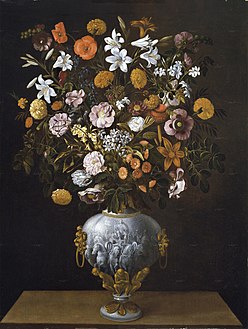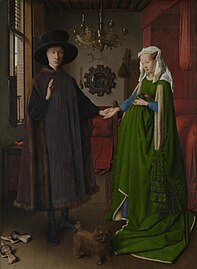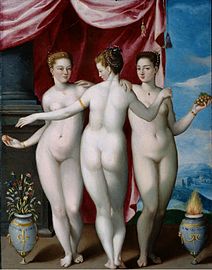Oil painting
Oil oil, a word from the Latin oleum ("oil"), is a painting technique. It consists of mixing the pigments with an oil-based binder, usually of vegetable origin. By extension, the pictorial work executed using this technique is called oil, which admits supports of a very varied nature: metal, wood, stone, ivory, although the most common is that it is applied on canvas or board.
The oil remains wet for a long time, which favors the mixture of colors. Its drying can be compromised depending on the additions that are put on it during the process, such as the cobalt dryer, which can crack the oil when it dries.
History
The use of oil has been known since ancient times, the oldest paintings found using this technique are found on murals in the Bamiyan caves in Afghanistan, dating from the mid-century VII, although from how mature it seems, the technique was probably already known in Asia long ago. In the Middle Ages the use of oil was already widespread among artists, although in a minority, since at that time tempera or fresco painting predominated. At the end of the XIV century and during the XV, the use of oil began to be generalized to the detriment of other techniques, since it allowed a slower drying of the paint, corrections in the execution of the excellent stability and conservation of color. The Flemish painters were the first to use oil on a regular basis, and its invention is attributed to the painter Jan van Eyck, although this is not entirely true.
The most widely used oil was linseed, but it was not the only one and each artist had their own formula that was kept secret. Normally the essence of turpentine is used as a solvent, to achieve a more fluid or more impastoed brushstroke, depending on the case. Many followed the advice and experiences written in the Treatise of the Monk Theophilus which is already known and is mentioned in the year 1100. Cennino Cennini, in his Book of Art, also mentions and describes the technique.
The preparation of the support to receive the paint varies according to its nature. Normally, a series of layers of animal glue and plaster are applied, which make the surface smooth and uniform; this is called priming. Although at first most of the oil paintings were on a wooden support, from the XVII century with Baroque art The painters chose canvas as their favorite support for their paintings, being this more practical for the elaboration of large compositions due to its ability to be rolled up, in addition to suffering less from thermal variations and the attack of xylophagous insects.
The painting obtained with the mixture of oils offered many advantages to the painter, among others, being able to carry out his work slowly and without haste (the opposite of what happened in tempera or fresco painting), being able to retouch the work, vary the composition, colors, etc. Precisely because of these qualities, it was the favorite technique of painters such as Leonardo da Vinci, Titian or Velázquez, who valued a thoughtful execution and subject to continuous corrections. Leonardo experimented with various variations of the technique, such as its application on walls as a fresco, or the invention of varnishes and oily textures of different consistencies, which ended in resounding failures. But, as a counterpart, he managed to take the technique to new heights, with the invention of sfumato or soft gradation of light, achieved based on successive very light layers of paint (glaze).
Van Eyck, like the other Flemish painters, used oil as a miniaturist, trying to capture the details and resulting in an enamel painting; the Venetian pictorial school (Tiziano) will contribute as a novelty the possibilities of texture of the brushstrokes, experiences that will be picked up later, among others, by the Flemish Rubens and the Dutch Rembrandt; the latter tried new techniques such as scraping. All these ways of painting were the academic method until the 19th century. Beginning with Impressionism, painters used colors practically without mixing or diluting, and on many occasions without a sketch or prior design.
The equipment used by painters is usually made up of brushes (animal bristles, especially sable; also synthetic hair), of different sizes and shapes, spatula, easel and palette. You can work on a previous sketch, or without it.
Oil on wall
First, the artist prepared the wall to receive the paint (primer). The technique is described by Giorgio Vasari (1511-1574), architect and theoretical painter of Italian art in his work Le Vite.
First the surface of the glow is saturated with several layers of cooked oil, until reaching the point where the wall no longer absorbs. When the dry surface is applied a layer of white lead, oil, yellow lead and refractory clay. They give the last layers with very fine marble powder and lime, plus an application of linen oil. To finish, a hand of Greek fish is spread.
The use of oil on the wall has been a minority in the history of art, since other techniques such as fresco are much more stable and durable. However, some outstanding works, such as The Last Supper by Leonardo Da Vinci or the Black Paintings by Francisco de Goya used this technique.
Oil on board
This technique was used preferentially by Flemish painting artists. However, a large number of early Renaissance Italian paintings were painted on panel. The board was prepared with a layer of white earthy carbonate of lime (chalk) and animal glue (gesso). In this way the wood was compact and smooth, waiting for the paint.
Oil on canvas
It has been the favorite support from the Renaissance to the present day, due to its ease of transport and storage and optimal preservation. The fabric prevents annoying and unsightly cracks that often appear in wood due to thermal or humidity fluctuations, and allows larger paintings to be made. In addition, many artists take advantage of the weave of the fabric to create particular expressive effects. Canvases tend to have a more matt appearance than panel painting, although this is often mitigated by applying varnishes as a final finish. The most used fabrics for painting are linen, burlap and cotton.
Venetian artists at the end of the 15th century were the first to use free-standing canvas mounted on a frame. The canvas reached its maximum splendor as a support in the XIX century with the Impressionists, when painting began to spread outdoors and lighter and easier to transport supports became necessary. Today, it continues to be the favorite of many artists, but with new techniques when applying oil. An example is the exclusive use of the hands, visible in painters like Iris Scott.
Oil on other supports
The use of supports other than board or canvas was very minor, although not scarce, since from the Baroque the fashion for luxurious objects with a strange or novel appearance was imposed, which is why we know oil paintings on precious stones, metals, glass, and even ivory, which became very fashionable in the romantic era. These supports often present conservation problems, since the adherence of the oil to these non-porous surfaces is less. As for stones, painting on agate and marble was usual, with other supports such as aventurine being more rare. Such supports, due to their exoticism and beauty, increased the value of the paintings.
As for metals, without a doubt the most used was copper. It was a very popular support from the end of the XVIII century, in generally small works. The advantages it offers are its stability and durability, and the uniform surface of the metal, which allows a smooth and shiny finish.
Oil by glazes
Oil oil worked with glazes is the painting technique that was most used in the Renaissance. It was also frequently used by later artists. Rembrandt, for example, finished his paintings with numerous transparent colored glazes on the dry base. The glaze consists of very thin layers of paint diluted in varnish or turpentine, so that the lower layer is transparent, thus the color that we will see is the result of the mixture of the lower color plus that of the glaze. Commonly used is German varnish, made from 1/3 linseed oil, 1/3 turpentine, and 1/3 Damar varnish.
Binder
Oil oils were mainly used in the past with linseed oil only, currently there are other means to use as a binder in paint such as the aforementioned linseed oil, as well as bidistilled white spirit and damár varnish, these together in equal amounts would work as a binder with greater anchorage to the surface of the fabric or support.
Pigments
Traditionally the artist prepared his own colors, mixing pigments with linseed oil and resin. At the end of the s. Tubes with ready-made oil colors began to be marketed in the 19th century. Each master had his own recipes and there are many curiosities associated with the manufacture of colors, such as mummy brown obtained from mummy powder marketed for medicinal uses in the 12th century or the Indian yellow highly appreciated by Flemish painters of the 17th and 18th centuries, produced from the urine of cattle fed only mango leaves.
Currently many natural pigments have been replaced by cheaper and less toxic synthetic pigments, although they have retained their historical names, for example:
- Ultramarine blue: at its origin the pigment was obtained from a semiprecious stone, lapislázuli. It was the color used in the painting of the Virgin's mantle, and it was frequent that its quantity, use and extension was subject to very precise specifications in the contracts made between the comites and the artist, as well as the use of the golden bread. One of the most expensive pigments of his time because it was brought from Afghanistan.
- Chrome yellow: originally made from lead chromat, an intense color pigment with variations from light to almost orange tones. He was employed until the middle of the centuryXIXand one of the colors preferred by Vincent van Gogh. The high toxicity of the chromium, as well as its little stability in the light, were left unused.
- Carmine: traditionally produced with chonches Kermes vermilioand from the centuryXVI, with American chochinilla, was a pigment of an intense but unstable red in light in its oil use.
- Cardenillo: the oil painting prepared with this pigment obtained from the copper green patina, also known as verdigris, was initially presented with a green-blue color and took about a month to reach its stable green tones, as well as being extremely toxic.
The cardenillo and the aloe, as well as the curcuum and the hiel, provide a beautiful green; this also happens with the goldpimente burnt and saffron, although they will soon be black, as I fear. Mixing vivid yellow and navy blue you get a beautiful green for the fresco. The cardenillo and the lacquer provide the oil blue with magnificent shadows.Leonardo Da Vinci, Painting Treaty1498.
Examples of Famous Works
Contenido relacionado
972
Saddam Hussein
1070












